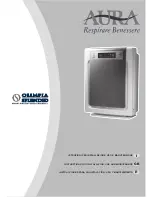
4
36"
36"
10"
UNIT
WALL
36"
FIGURE 1
Rooftop Installation (Figure 2)
1.
Before locating the unit on the roof, make sure that the
strength of the roof and beams is adequate to support the
weight involved. (See specification sheet for weight of units.)
This is very important and the installer’s responsibility.
2.
Make proper consideration for the weather–tight integrity of
the roof and proper drainage of condensate.
3.
To ensure proper condensate drainage, unit must be
installed in a level position.
4.
Consideration should also be given to shade, appearance
and noise.
36"
36"
24"
PL
EN
UM
UN
IT
PL
AT
FO
RM
CU
RB
FIGURE 2
DUCTING
WARNING
D
O
NOT
,
UNDER
ANY
CIRCUMSTANCES
,
CONNECT
RETURN
DUCT
-
WORK
TO
ANY
OTHER
HEAT
PRODUCING
DEVICES
SUCH
AS
FIRE
-
PLACE
INSERT
,
STOVE
,
ETC
. U
NAUTHORIZED
USE
OF
SUCH
DEVICES
MAY
RESULT
IN
PROPERTY
DAMAGE
,
FIRE
,
CARBON
MONOXIDE
POISONING
,
EXPLOSION
,
PERSONAL
INJURY
OR
DEATH
.
• Structural strength of supporting members
• Clearances and provision for servicing
• Power supply and wiring
• Air duct connections
• Drain facilities and connections
• Location may be on any four sides of a home,
manufactured or modular, to minimize noise
Clearance
The unit is designed to be located outside the building with
unobstructed condenser air inlet and discharge.
Additionally, the unit must be situated to permit access for
service and installation. Condenser air enters from three
sides. Air discharges upward from the top of the unit.
Refrigerant gauge connections are made on the right side
of the unit as you face the compressor compartment.
Electrical connections can be made either on the right or
left sides of the unit. The best and most common application
is for the unit to be located 10” from wall (4” minimum) with
the connection side facing the wall. This “close to the wall”
application minimizes exposed wiring.
Close to the wall application assures free, unobstructed air
to the other two sides. In more confined application spaces,
such as corners provide a minimum 10” clearance on all air
inlet sides. Allow 18” minimum for service access to the
compressor compartment and controls. The top of the unit
should be completely unobstructed. If units are to be located
under an overhang, there should be a minimum of 36”
clearance and provisions made to deflect the warm discharge
air out from the overhang.
Location
Consider the affect of outdoor fan noise on conditioned space
and any adjacent occupied space. It is recommended that
the unit be placed so that condenser air discharge does
not blow toward windows less than 25 feet away.
The unit should be set on a solid, level foundation - preferably
a concrete slab at least 4 inches thick. The slab should be
above ground level and surrounded by a graveled area for
good drainage. Any slab used as a unit’s foundation should
not adjoin the building as it is possible that sound and
vibration may be transmitted to the structure. For rooftop
installation, steel or treated wood beams should be used
as unit support for load distribution.
Heat pumps require special location consideration in areas
of heavy snow accumulation and/or areas with prolonged
continuous subfreezing temperatures. Heat pump unit bases
have holes under the outdoor coil to permit drainage of defrost
water accumulation. The unit must be situated to permit
free unobstructed drainage of the defrost water and ice. A
minimum 2" clearance under the outdoor coil is required in
the milder climates.
Outside Slab Installation (Figure 1)
1. The unit must be mounted on a solid, level foundation.
2. Select a location that will minimize the length of the supply
and return ducts.
3. Select a location where external water drainage cannot collect
around the unit.
4. Consideration should also be given to shade, appearance
and noise.





































